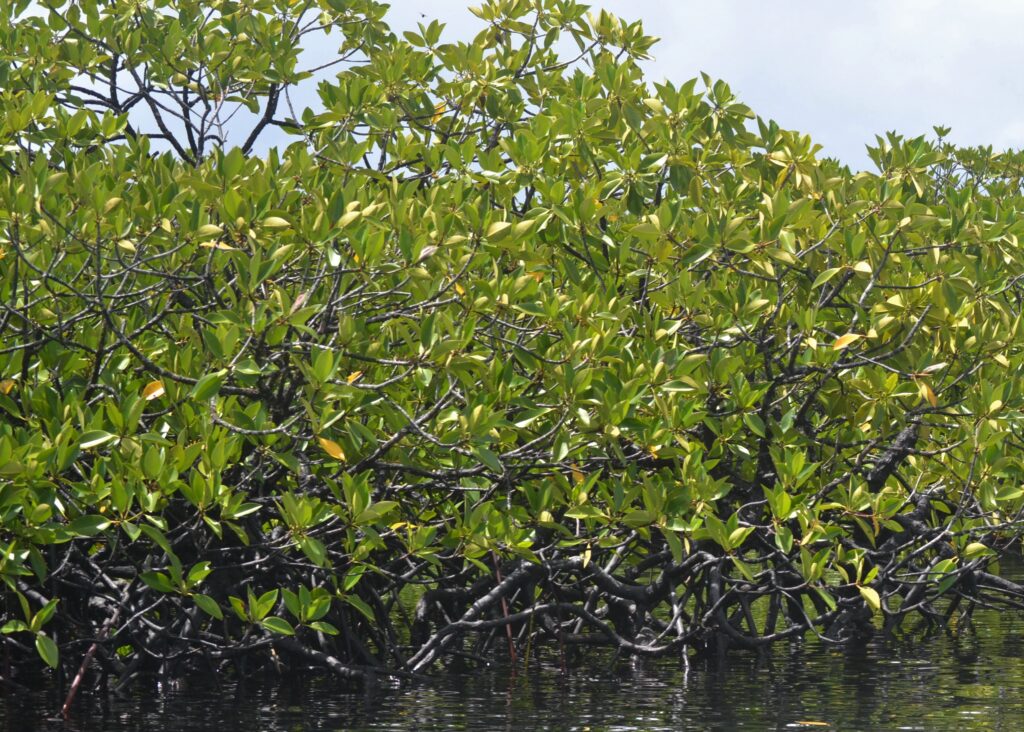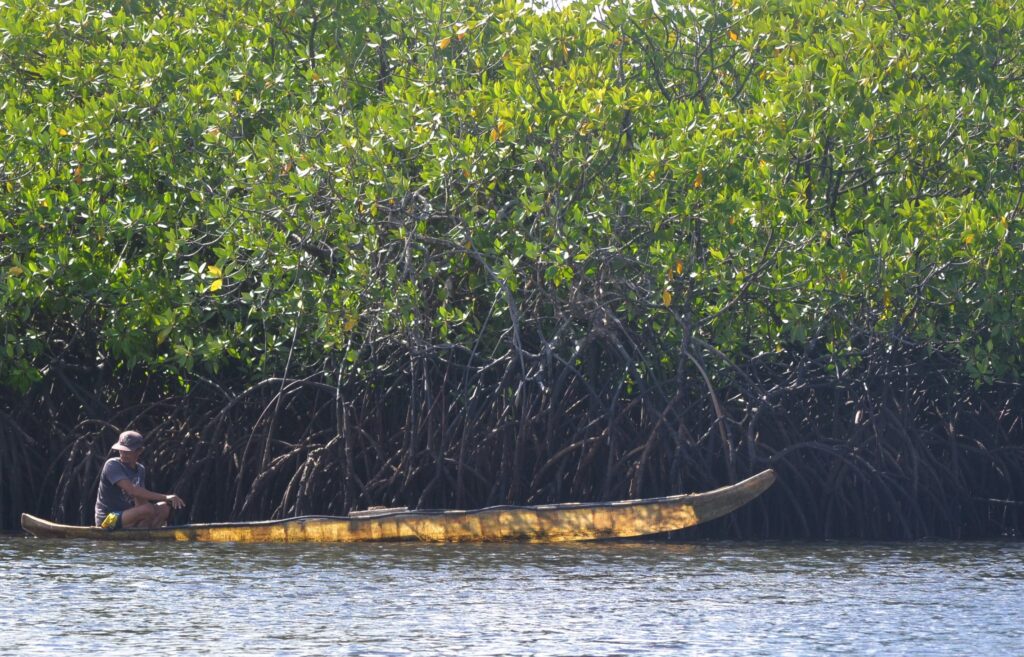Text and Photos by Henrylito D. Tacio
They may be 100 times fast in storing carbon dioxide than those forests growing in the uplands, but seagrass meadows and mangrove forests are not given the attention they most deserve. In fact, they are quickly disappearing!
“They are at great risk of being lost and if the trend continues at current rates, a further 30-40% of seagrasses and nearly all unprotected mangroves could be lost in the next 100 years,” deplored Dr. Miguel D. Fortes, a marine scientist and author of several books and technical articles in refereed journals.
Part of the coastal ecosystems, seagrass meadows, and mangrove forests have the natural capacity to sequester and store enormous amounts of so-called “blue carbon” in their sediments.
“As carbon sinks, they are a cheap and readily available natural resource useful in mitigating the negative impacts of climate change,” explained Dr. Fortes, the first Filipino to receive the prestigious International Biwako Prize for Ecology. “Once they are degraded or destroyed, their blue carbon stores are released as carbon dioxide and contribute to global climate change.”
Dr. Fortes said that the current rates of loss of these ecosystems might result in 0.15 to 1.02 billion tons of carbon dioxide released annually. “Hence, it is imperative that these blue carbon ecosystems be conserved and well-managed,” he suggested.
“Blue carbon ecosystems”
Blue carbon is actually carbon from the atmosphere and oceans. The coastal “blue carbon ecosystems” sequester these emitted carbon dioxide is going to the atmosphere as these are stored in the plants and sediment. As a result, they help mitigate climate change impacts.
The global community established the International Blue Carbon Initiative, a transdisciplinary, global program that coordinates the International Group of Experts on Blue Carbon (IGEBC). The latter has formulated an action plan to “identify effective, efficient and politically acceptable approaches to reduce the atmospheric concentration of carbon dioxide.”
Recent studies conducted by the United Nations Environment Program and International Union for Conservation of Nature found that, when healthy mangrove forests, saltwater marshlands, and seagrasses are “extremely effective” at storing atmospheric carbon, thereby mitigating climate change consequences.

“Climate change is occurring now and will intensify in the next few decades, threatening in particular developing nations, with the Philippines being one of the most vulnerable countries in the world,” said the World Bank report, “Getting a Grip on Climate Change in the Philippines.”
According to the bank report, the Philippines is “already experiencing temperature increases; sea level rise; stronger storms, floods, and droughts; and ocean acidification, all of which will intensify and affect subsistence livelihoods as well as urban and coastal areas.”
Climate change
Dr. Robert Watson, chairman of the Intergovernmental Panel on Climate Change (IPCC), a United Nations body which became a co-recipient of the 2007 Nobel Peace Prize, explained climate change in these words: “Climate change is very simple. We are increasing emissions of greenhouse gases, and thus, their concentrations in the atmosphere are going up. As these concentrations increase, the temperature of the earth rises.”
Examples of greenhouse gases include carbon dioxide, methane, and nitrous oxide. “Our lifestyle has led to the accumulation of greenhouse gases in the atmosphere,” a fact sheet on climate change explained. “These gases trap heat from the sun, making the earth warmer. Manifestations of a warmer world include rising mean temperatures, sea level rise and increase in the frequency and intensity of extreme weather events like droughts and greater rainfall.”
“Continued emission of greenhouse gases will cause further warming and long-lasting changes in all components of the climate system, increasing the likelihood of severe, pervasive and irreversible impacts for people and ecosystems,” contends an IPCC report.
Mangroves and seagrasses
Both mangrove forests and seagrass meadows can help capture those emitted carbon dioxides from going to the atmosphere. Unfortunately, these ecosystems, together with coral reefs, continue to degrade and, “in the face of natural catastrophes, are at great risk of being lost in the new few decades,” Dr. Fortes warned.
In 1918, the country’s mangroves were estimated to cover 5,000 square kilometers. By 1970, they had dwindled to 2,800 square kilometers and to 2,420 square kilometers a decade later.
“All over the country, whatever coastal province you visit, you see the same plight – desolate stretches of shoreline completely stripped of mangrove cover and now totally exposed to the pounding of the ocean’s waves,” a Filipino environmentalist decries.

“Mangroves in the Philippines have long been ‘ecologically disturbed’ by rampant cutting for timber products and massive conversion of forests into aquaculture ponds,” read the introduction and overview of the “State of the Mangrove Summit.”
The seagrasses, thriving between coral reefs and mangroves, fare no better. “In the Philippines, 30% to 50% of seagrass has been lost in the last 50 years,” pointed out Dr. Fortes.
To think, the Philippines has the second-highest number of seagrass species in the world. The country is home to 16 of the world’s 50 seagrasses; only Western Australia has more – with 17 species.
Dr. Fortes said all 16 seagrass species are widely distributed from Bolinao Bay in the north, Palawan, and the Cebu-Bohol-Siquijor area at the center, and Zamboanga and Davao in the south. Seagrass beds cover an estimated area of about five million hectares.
Marine experts traced the rapid disappearance of seagrasses to various destructive disturbances caused by both natural and man-induced influences. Among the natural threats are typhoons, tidal waves, and volcanic activity.
Human-made causes include industrialization, development of recreational areas along the coast, dredging, and mining, which led to heavy siltation in estuarine areas, resulted in lower productivity and even burial of seagrasses, according to a report from the Department of Environment and Natural Resources.
Ignored
Despite their massive importance, both mangroves and seagrasses have been ignored in the past. “In the Philippines, scientific understanding of carbon sequestration and potential emissions from coastal ecosystems is still insufficient to develop effective carbon policy, management, and conservation incentives for coastal Blue Carbon,” he wrote in a briefing paper.
Blue carbon was acknowledged globally only in 2009. “The common drivers of conversion and degradation of blue carbon ecosystems are largely driven by human activities,” Dr. Fortes said, referring to aquaculture, agriculture, mangrove forest exploitation, terrestrial and marine sources pollution, and industrial and urban coastal management.
“Greenbelt”
But there is good news. According to Dr. Fortes, approximately a kilometer-wide strip of seagrass (seaward) and mangrove (landward) vegetation runs practically all along the Philippine coastline.
He considered this as “greenbelt,” which acts “as a composite natural buffer against storm surge, rise in both seawater and air temperatures, seawater acidification, flooding and pollution.”
The country’s mangroves, for instance, can potentially sequester 0.2 billion metric tons of carbon or an equivalent of cleaning the air from carbon emissions of 3 million cars). The mangrove forests can also reduce the height of big waves by 75% and substantially increase biological diversity.
On the other, the seagrass beds have the potential of sequestering 0.02 billion metric tons of carbon (cleaning the air of carbon equivalent to that from emissions of 270,000 cars). They can also add oxygen to seawater, aside from aerating it and maintaining favorable water temperatures. In addition, they remove carbon dioxide from seawater.
“The Philippines has enormous coastal blue carbon resources useful in sequestering carbon dioxide from the global atmosphere,” reminded Dr. Fortes. “However, it has also the potential to add carbon dioxide into the atmosphere if it does not manage well its coastal blue carbon ecosystems.”
Dr. Fortes believed the Philippines could still reverse the loss of mangroves and seagrasses. “An improved scientific and societal understanding of the underlying mechanisms that conserve coastal ecosystems are at hand,” he said. “The blue carbon focus could enhance partnerships in improving resilience of communities towards a blue economy in the face of climate change.”

